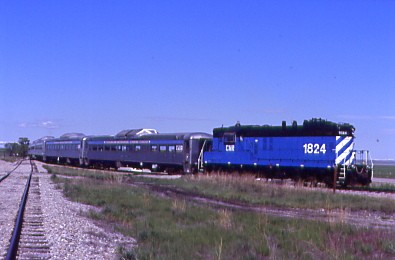
I had breakfast at the Yogo Inn before checking out ahead of the crowd then drove out to the loading spot, taking a few pictures along the way.
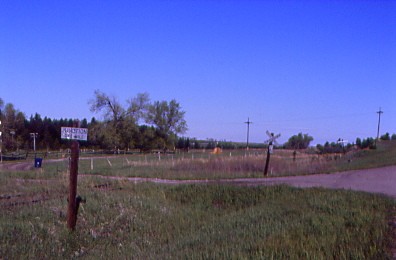
The former Milwaukee Road siding at Hanover at MP 70.
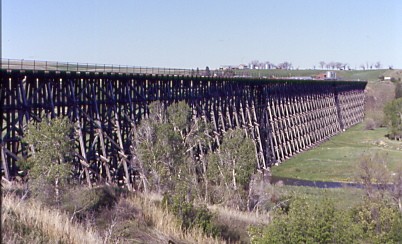
The-out-of-service Spring Creek trestle at MP 70.8.
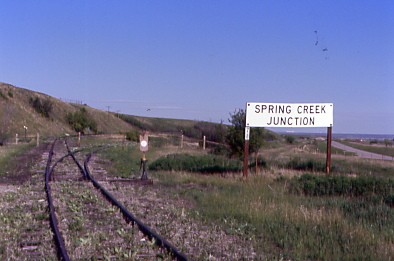
The BN sign at Spring Creek Junction, the start of former joint track of the Great Northern and the Milwaukee Road into Lewistown at MP 71.0.
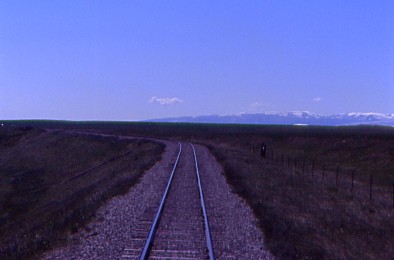
The connecting track from the former Great Northern to the former Milwaukee Road.
The train was there but the locomotive had gone to Denton last night doing some freight work along the way. It was a perfectly clear Big Sky Montana morning as I waited listening to Frank Zappa on my headphones then spotted a headlight coming through Danvers off in the distance. It arrived at Kingston Junction at 9:50 AM and after pictures were taken, Martin and I waited and killed nine flies that thought our window must have been the way out. It was the way to their death!
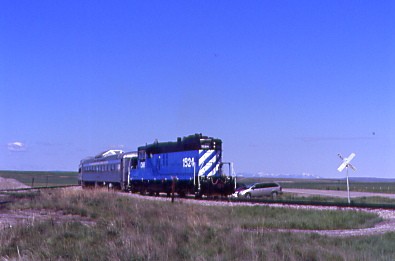
When the various rail lines were being built through the area, towns and few and far between. Even reports from the Milwaukee's construction through the area just after 1900 included comments about the distance between farmhouses. Reports talked about 100 mile-long fields of alfalfa and 50 miles between farmhouses. Even as late as 1910, in this part of the country, civilization was following the railroad, not the other way around.
The line between Harlowtown (named for Richard A. Harlow, a lawyer and real estate promoter from Helena) and Agawam (north of Great Falls) was started in 1903 as an extension of the Montana Railroad, known as the Jawbone. The Montana Railroad was started as the Montana Midland out of Lambert on the Northern Pacific Railroad. Harlow built the line to get access to the low grade ores from the Cumberland Mine in the Castle Mountains to the west of Harlowtown. Reportedly, the term jawbone was applied to the line because of the way that Harlow kept jawboning about the fortune his railroad would make. Harlow named Lambert after his chief engineer, Arthur B. Lambert, who returned the favour by renaming Merine (where the line to Lewistown began) to Harlowtown.
Because the Montana Railroad was in extreme debt and the ore movements wree not covering their costs, the line was very soon up for sale. Since the line occupied the only easy route through the Castle Mountains, the west-building Milwaukee line looked upon it ias a logical acquisition. The Milwaukee worked out an arrangement to lease the property and then had Harlow pay off James Hill (who gained control of the notes on the line) and then sell the Montana Railroad to the Chicago, Milwaukee and Puget Sound Railway of Washington. That railroad then deeded the line to the Milwaukee in 1910. Thus, the growing Milwaukee acquired the beginnings of the line that became part of Central Montana Rail.
Soon after the Milwaukee's purchase of the Montana Railroad, construction northward on the line was resumed to reach the rich grain fields and new homesteads in the area. The line through Lewistown was looked at as a feeder line for the Milwaukee's main east-west line. Trainloads of train would be collected from along the line and sent either east or west to market. During late steam days, the line featured double-headed steam pulling trains of boxcars filled with grain. With the line always featuring light rail, the Milwaukee Road used their lightest Mikado steamers on the line. Mikados made up the largest class of steamers on the railroad and many lasted to the very end of steam due to their ability to operate on the many light-rail branch lines in the area.
Passenger service ended early on this line. This service used a motor, a self-propelled passenger car, which makes it somewhat appropriate that our Central Montana Rail train is made up of RDCs, since they are a modernized version of what was used on the line.
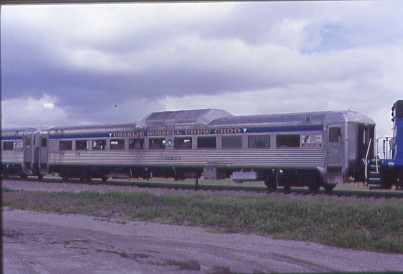
Central Montana Rail RDC-9 6918, ex. North Shore Scenic Railroad 6918, exx. Massachusetts Bay Transportation Authority 6918, nee Boston and Maine 6918 built by Budd Company in 1956. Today's consist was the same as yesterday, namely Central Montana Rail GP9 1824, RDC-9 6918, RDC-9 6926, RDC-1 6138, RDC-9 6906 and RDC-9 6916.
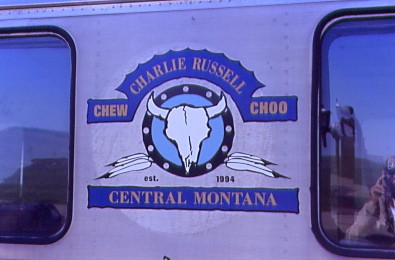
The Charlie Russell Chew Choo emblem.
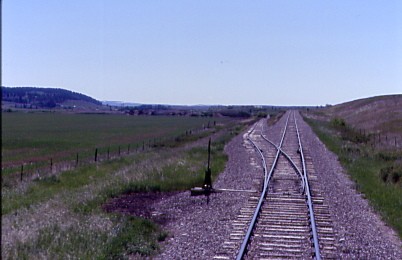
The train departed Kingston Junction at 11:00 AM and started our last rare mileage trip by taking the new connecting track from the Great Northern-built line to the Milwaukee Road line built in 1986. Spring Creek was off to our right down in the valley and we passed through Amherst at MP 73.8 prior to crossing Big Spring Creek on a fill then ran by the Gravel Mountain spur at MP 74.7.
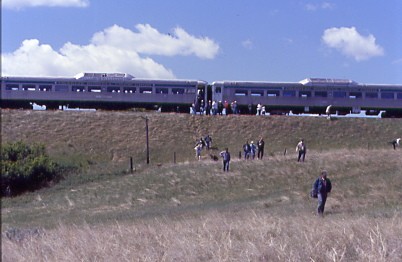
Detraining for the first photo runby.
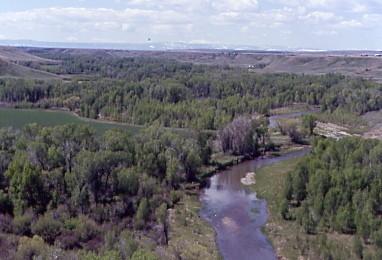
Judith River, named in 1805 by Lieutentant Clark of Lewis and Clark in honour of Miss Judith Hancock of Faircastle, Virginia, who later became his wife. The mouth of the river, where it flows into the Missouri River about 35 miles to the north, has been used as a location for many events from a May 1805 camp for Lewis and Clark to several Indian treaty meetings, to the site for the first military fort in Montana. The river starts to the southwest in the Lewis and CLark National Forest area of the Little Belt Mountains, which are part of the Belt Mountains, named for an unusual rock formation in these mountains.
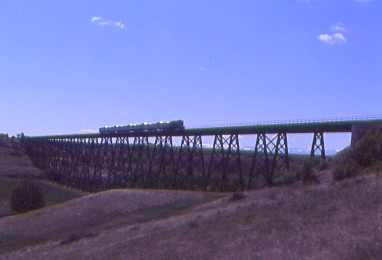
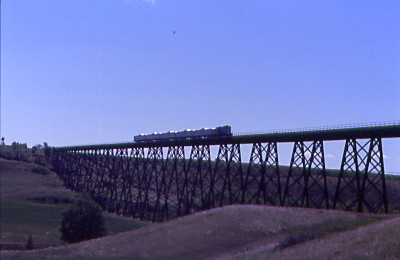
The photo runby at the Judith River Trestle, MP 75.7, which has 33 spans, is 150 feet high and has a length of 1,953 feet.
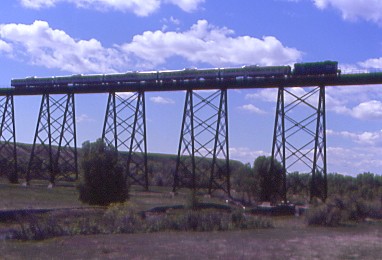
The train's speed allowed for many different angles.
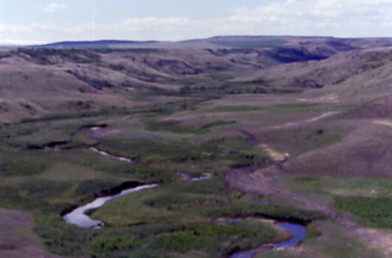
Once on the move again, we travelled the town of Ware, MP 77.1, which once had a water tank for steamers fighting their way over this line. In addition, two grain elevators, a service station, a post office, a school, two saloons and about 350 people once populated the town. By 1952, only two or three families remained and the post office closed in 1954.
We next crossed Indian Creek Trestle at MP 79.7, with its 22 spans, 150 feet high and a length of 1,303 feet. Indian Creek is a small stream flowing to the north, where it joins the Judith River. While small, it is responsible for this large, deep gorge that is crossed by the trestle.
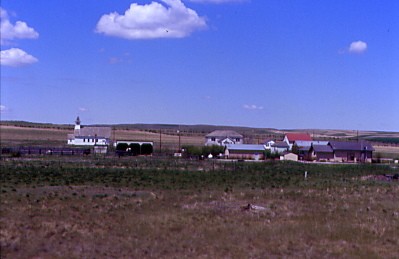
The train ran through Danvers, MP 80.6. C.A. Goodnow, assistant president of the Milwaukee Road, named this place after an old Massachusetts town. However, before the railroad arrived in 1914, it was called Warwick. Like many towns in the area, it was bustling before World War I as homesteaders arrived by the trainload.
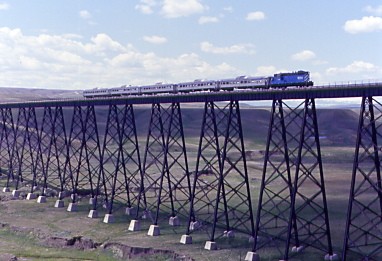
Danvers before crossing a high fill across Stockman Coulee then we curved right before rolling out onto the Sage Creek Trestle at MP 84.1, our next photo runby location.
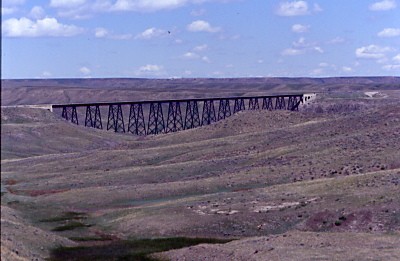
Sage Creek trestle, which has 29 spans, is 150 high and 1,698 feet long.

Sage Creek, which flows into the Judith River just a mile or so east of here.
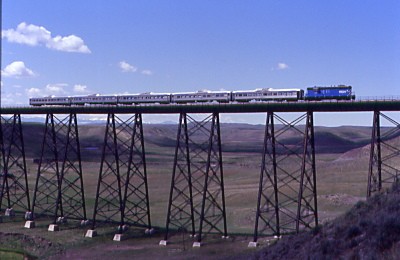
Sarah, Bart's wife, now has the nickname of Goddess of Clouds as she has the power to bring clouds across the skies during runbys either by putting on her sunglasses or squinting and thinking about putting them on.
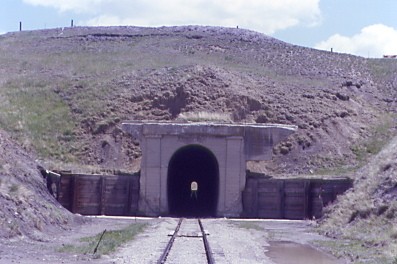
The train next ran through the Sage Creek/Hoosac Tunnel at MP 84.1, a 2,014 foot long affair built in 1912-1913, which the Milwaukee Road called Tunnel 1 before going through the little town of Hoosac at MP 88.7. If all these names sound as if they should be in New England, they were named by C.A. Goodnow. Lunch was served next with me having a roast beef sandwich and Martin a ham sandwich.
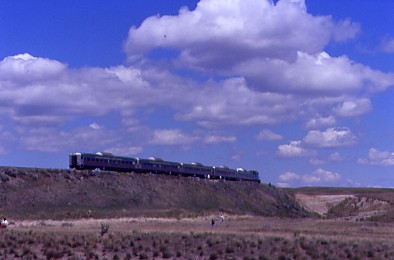
Big Sky Country.
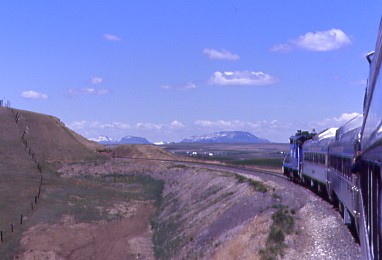
Rounding a large curve before Square Butte.

Square Butte came into view before we reached Denton.
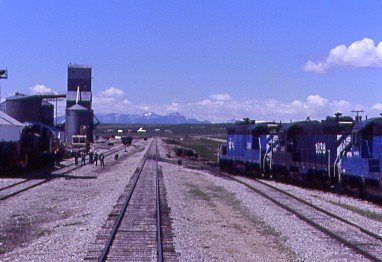
Denton, MP 95.6, is the headquarters of Central Montana Rail with its shops, from which they brought out the rest of their locomotive fleet.
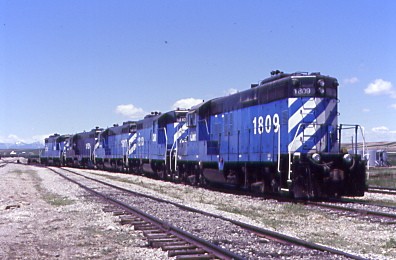
The Central Montana Rail GP9 fleet.
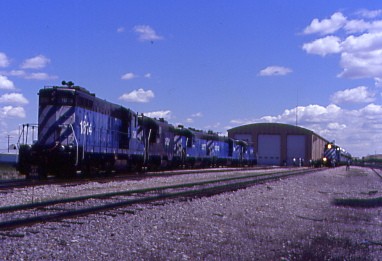
Denton was named for the Dent Brothers who owned the land on which the first townsite here was located. In 1888, the first post office was established with Harry Dent as postmaster. The major business in this area was farming. Denton once was a busy livestock centre with a sizeable stock yard facility. The population was 301 in 2000 and the town is at 3,610 feet in elevation and was established as a weather station on July 1, 1918, because it is in the centre of a large plateau area.
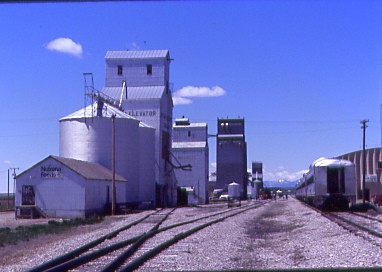
The rear of our train.
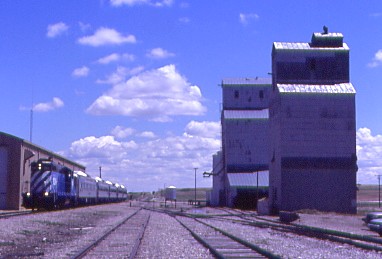
Our train with a Montana Grain Elevator Company grain elevator.
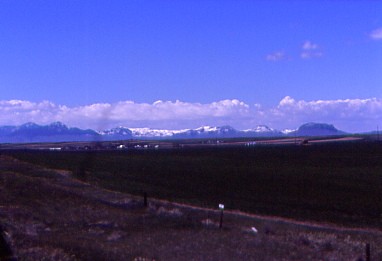
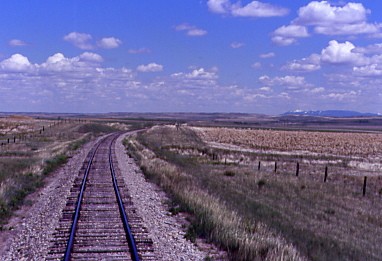
More of Montana Big Sky Country. Leaving Denton we crossed Wolf Creek as we continued across the rolling prairie.
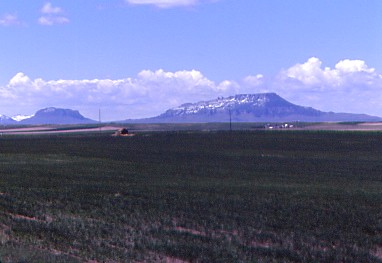
Square Butte and Round Butte came into view before we ran south of the town of Coffee Creek then crossed the creek of the same name at MP 101.6 and proceeded to the township of Arrow Creek at MP 106.4.
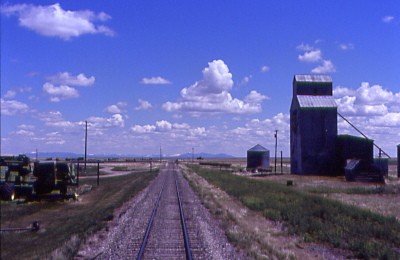
The former flag stop of Arrow Creek, which was first settled by stockmen in the 1880's, after which we descended into the Surprise Creek Canyon on a 1.4 percent grade.
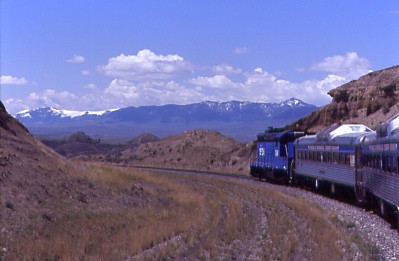
Curving into the canyon.
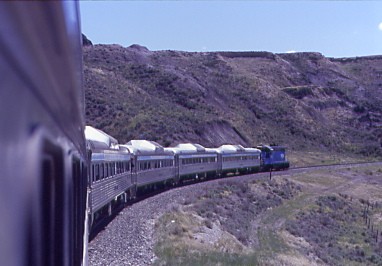
Descending towards the loop, where we all detrained for the next runby.



The third runby in Surprise Creek Canyon at MP 107, after which we resumed our downgrade journey then crossed Surprise Creek on a reversing curve.
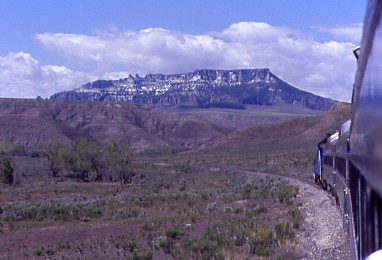
We continued to follow the creek, crossing it two more times, on the way to Pownal at MP 117.4, and had dropped 630 feet since we left Arrow Creek and looped down into Surprise Creek Canyon.
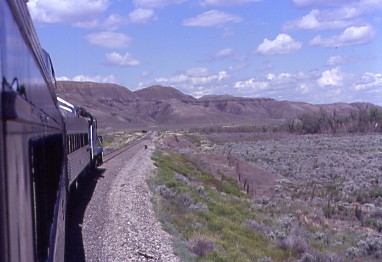
Near the end of Surprise Creek, where it joins Arrow Creek, as well as Montana Highway 80 northwest towards Geraldine.

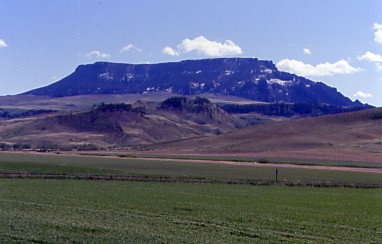
Square Butte, at MP 129.4, stands guard to the west as we crossed Little Battle, Butte and Cowboy Steele Creeks.
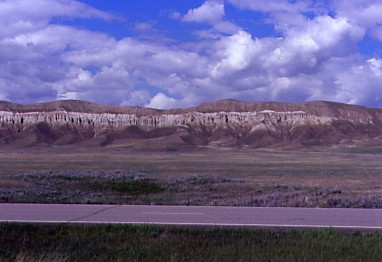
Hoodoos, tall skinny shafts of rock that protrude from the bottom of arid basins which are most commonly found in the High Plateaus region of the Colorado Plateau and in the Badlands regions of the Northern Great Plains.
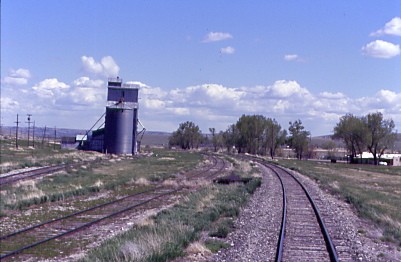
The town of Square Butte and six miles later, we crossed Flat Creek before arriving at Geraldine, MP 137.0.
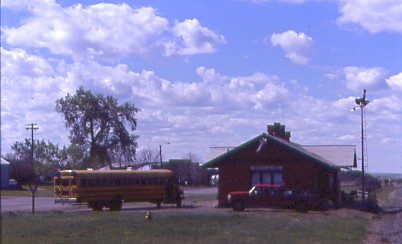
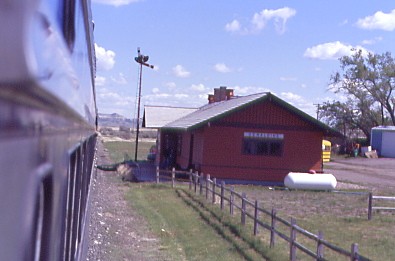
Geraldine is the center of a large wheat-producing region and an important source of business on this line when the Milwaukee Road operated it. Geraldine ws named after Geraldine Rockefeller, wife of William Rockefeller who was a director of the Milwaukee Road. We passed the station, built in 1914, which has been restored as is on the National Register of Historic Places, before reaching the end of the track and reversing to the station, thus ending the Rare Mileage trips of this weekend.

Looking back at Geraldine from the end of track. Half of our group immediately boarded one of the buses to leave right away but instead of leaving, the bus driver just talked incessantly. Once on the road, he continued to talk overt the public address system and made several bad jokes, including one which insulted all of us from California and Oregon. Some Frank Zappa music helped me pass the time and we returned to the cars at Kingston Junction at at 6:00 PM.
The Drive to Lincoln, Montana 5/25/2004Instead of driving back via Lewistown, I elected to take the gravel roads to Moccasin which saved at least thirty minutes, then drove US 87, and later US 89 joined the road into Great Falls. Every traffic light was in my favour except for one where I stopped to have dinner at Arby's then I stayed on US 89 until Montana Highway 200 split off and took that, later crossing Rogers Pass with animals out in the twilight hour. I arrived in Lincoln at 9:05 PM and checked into the Ponderosa Leapers Motel where I received Cabin 13 then watched Game 3 of the Los Angeles Lakers-Minnesota Timberwolves NBA series in the fourth quarter and called home. The Lakers won 100-89 and I called it a night.
Back to Spokane 5/26/2004
Up at 6:00 AM and back on Montana 200 a few minutes later, I drove into Missoula for breakfast and petrol.
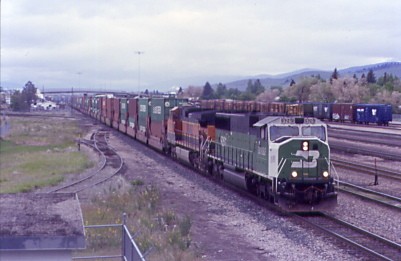
A Montana Rail Link stack train leaving town.
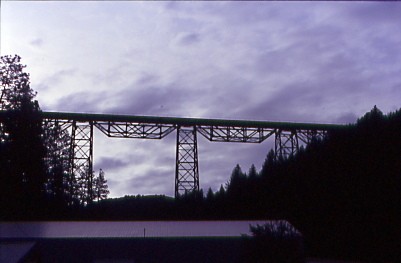
I drove west on Interstate 90 to US 93, taking this road over Evaro Hill with a stop at the high trestle.
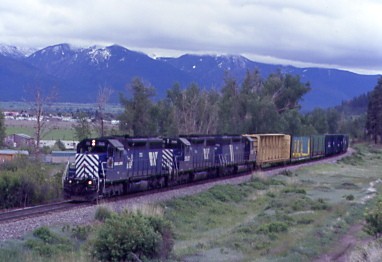
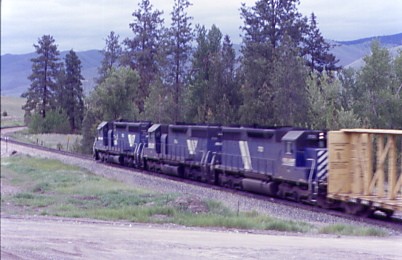
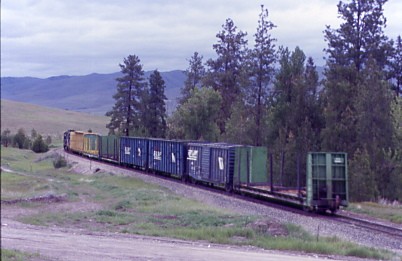
The Montana Rail Link Thompson Falls local west of Avon.
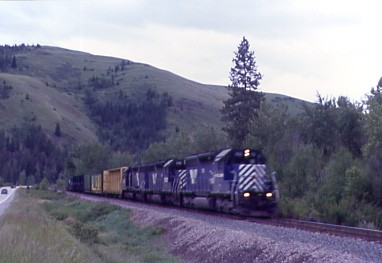
Further west, the local in a nice canyon.
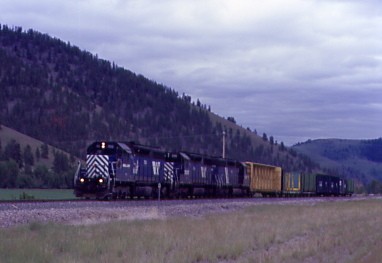
That train just east of Dixon. After Avon, I caught up to it again and photographed him at four locations over the next hour. At Ravalli, I was back onto Montana 200 all the way to Idaho, where it became Idaho 200, taking that along the north edge of Pend Oreille Lake then US 95 through Sandpoint.
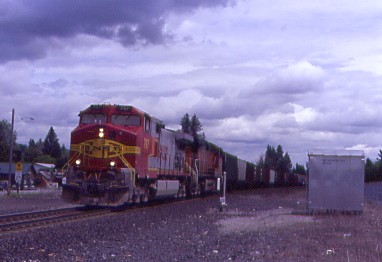
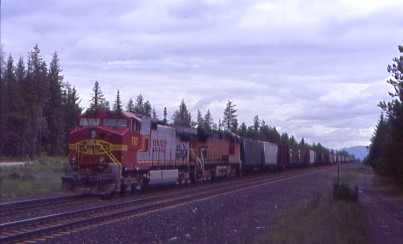
Staying on US 95 to Athol, I found a shortcut to Rathdrum and came upon a BNSF train in the siding in Ramsey then stopped for lunch at the A&W and caught the same train blasting through Rathdrum. I took Idaho 41 to Interstate 90, taking it out to almost the airport exit to the Holiday Inn in Spokane, where I would be spending the night then used their business center before filling the car with petrol for the last time. Back at the hotel, I relaxed the day away until after dinner at the hotel's Peppers Restaurant.
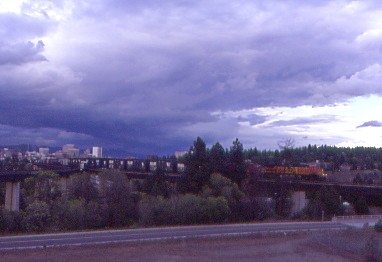
5/27/2004 The next morning I had the hotel's continental breakfast before checking out, driving to the airport, turning in my rental car and going through security with no problem then waited for my flight to board.
Southwest Airlines 2858This plane would take me from Spokane to Sacramento via Portland. Group "A" was boarded at 7:15 AM and we reversed from the gate at 7:34 AM, flying over the clouds to Portland as I listened to the Scorpions. We touched down at 8:36 AM and layed over until we departed there at 9:02 AM for Sacramento on a very rainy morning. We flew above the deck of clouds with no views until we came out of the clouds at Chico then descended into Sacramento on a beautiful clear morning, touching down at 10:21 AM. I now had the opportunity to rest until my next and last flight at noon and visited a newsstand for some snacks.
Southwest Airlines 1410While I waited, I listened to Yes' "The Ladder" then the "A" group was boarded late at 11:52 AM so I knew that the flight would leave late. We taxied away from the gate at 12:12 PM and flew over the Sacramento shops and the Amtrak station with a Capitol Corridor train ready to leave, and I spotted my brother Bruce's house as we flew over South Sacramento. I thought that our late departure would destroy my plan to ride Metrolink to Moorpark to take up some of the layover time, since that train would pass through Burbank eight minutes after the train if I took the shuttle to Burbank Downtown. We touched down at 1:15 PM and arrived at the stairs at Bob Hope Airport at 1:17 PM. I was first off the plane, found a quick way out of the terminal and taxied over to the Burbank Airport station with six minutes to spare.
Metrolink 109/116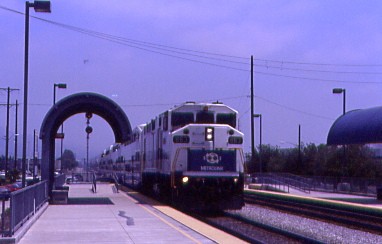
I was glad to be back on an Amtrak train bound for home. The fantastic conductor Hutch took my ticket and I read USA Today as we proceeded to Fullerton then as we made our way to Santa Ana, I listened to more Yes before arriving early at 4:57 PM. I walked through the station, saying hello to Marty, my wonderful night-time Amtrak agent, before I taxied home ending a wonderful set of rare mileage trips sponsored by the Southern Appalachia Railway Museum.
| RETURN TO THE MAIN PAGE |